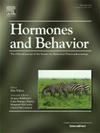Exposure to novel females increases fecundity in adult male prairie voles
IF 2.4
3区 医学
Q2 BEHAVIORAL SCIENCES
引用次数: 0
Abstract
Social circuitry of the mammalian brain can influence male reproductive physiology. This often manifests as plasticity in sperm production or allocation, particularly in response to male-male competition. However, socially mediated testicular plasticity has not been investigated with respect to mating and parental strategy. Testis mass and sperm production of sexually naïve and female-exposed adult male individuals of three rodent species were compared: the socially monogamous and paternal prairie vole (Microtus ochrogaster), the promiscuous meadow vole (Microtus pennsylvanicus), and the promiscuous house mouse (Mus musculus). Monogamously paired prairie vole males exhibited significantly larger testes and greater sperm production than naïve prairie vole males. Comparatively, there were no significant differences between naïve and monogamously paired male meadow voles or mice. To investigate the role of olfactory cues for regulating this phenomenon in prairie voles, a group of naïve males exposed to soiled bedding from novel females was used. These males were more similar to paired males than to naïve males not exposed to novel female odors, demonstrating a strong role of the social olfactory system. Further, the predictions of sperm competition theory (species with greater female promiscuity have larger testes than closely related species with less female promiscuity) are not observed between prairie voles and meadow voles. This demonstrates the complexity of intraspecies social dynamics and reproductive pressures which socially monogamous paternal males face and the evolutionary adaptations that may develop in response.
接触新的雌性会增加成年雄性草原田鼠的繁殖力
哺乳动物大脑的社会回路可以影响雄性生殖生理。这通常表现为精子产生或分配的可塑性,特别是对雄性竞争的反应。然而,社会介导的睾丸可塑性在交配和亲代策略方面尚未得到研究。比较了雌雄同体的草原田鼠(Microtus ochrogaster)、雌雄同体的草地田鼠(Microtus pennsylvanicus)和雌雄同体的家鼠(Mus musculus)的睾丸质量和精子产量。单偶配对草原田鼠的雄性睾丸明显大于naïve草原田鼠的雄性。相比之下,naïve与单配偶雄性草地田鼠或小鼠之间无显著差异。为了研究嗅觉线索在调节草原田鼠这一现象中的作用,研究人员使用了一组naïve雄性田鼠,这些雄性田鼠暴露于来自新雌性田鼠的脏被褥中。这些雄性更像配对的雄性,而不是naïve没有接触到新的雌性气味的雄性,这表明了社会嗅觉系统的强大作用。此外,精子竞争理论的预测(雌性乱交较多的物种比雌性乱交较少的近亲物种的睾丸更大)在草原田鼠和草地田鼠之间没有观察到。这表明了种内社会动态的复杂性和社会一夫一妻制雄性面临的生殖压力,以及可能发展的进化适应。
本文章由计算机程序翻译,如有差异,请以英文原文为准。
求助全文
约1分钟内获得全文
求助全文
来源期刊

Hormones and Behavior
医学-行为科学
CiteScore
6.70
自引率
8.60%
发文量
139
审稿时长
91 days
期刊介绍:
Hormones and Behavior publishes original research articles, reviews and special issues concerning hormone-brain-behavior relationships, broadly defined. The journal''s scope ranges from laboratory and field studies concerning neuroendocrine as well as endocrine mechanisms controlling the development or adult expression of behavior to studies concerning the environmental control and evolutionary significance of hormone-behavior relationships. The journal welcomes studies conducted on species ranging from invertebrates to mammals, including humans.
 求助内容:
求助内容: 应助结果提醒方式:
应助结果提醒方式:


